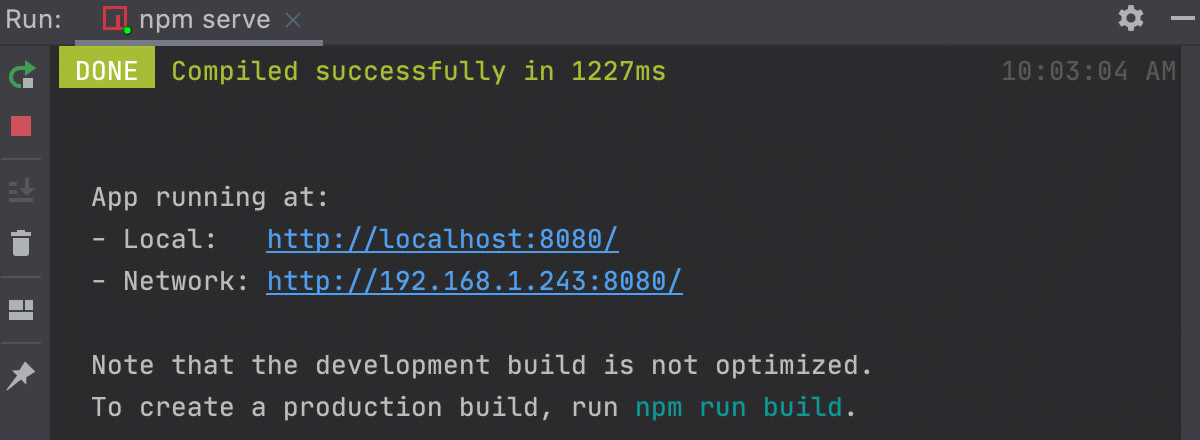Terminal
WebStorm includes an embedded terminal emulator for working with your command-line shell from inside the IDE. Use it to run Git commands, set file permissions, and perform other command-line tasks without switching to a dedicated terminal application.
Enable the Terminal plugin
This functionality relies on the Terminal plugin, which is bundled and enabled in WebStorm by default. If the relevant features aren't available, make sure that you didn't disable the plugin.
Press Ctrl+Alt+S to open the IDE settings and select .
Open the Installed tab, find the Terminal plugin, and select the checkbox next to the plugin name.
Initially, the terminal emulator runs with your default system shell, but it supports many other shells, such as Windows PowerShell, Command Prompt cmd.exe, sh, bash, zsh, csh, and so on. For information about changing the shell, see Terminal settings.
Open the Terminal tool window
From the main menu, select or press Alt+F12.
By default, the terminal emulator runs with the current directory set to the root directory of the current project. For information about changing the default start directory, see Terminal settings.
Right-click any file (for example, in the Project tool window or any open editor tab) and select Open in Terminal to open the Terminal tool window with a new session in the directory of that file.
Start a new session
To start a new session in a separate tab, click
on the toolbar or press Ctrl+Shift+T.

To run multiple sessions inside a tab, right-click the tab and select Split Right or Split Down in the context menu.
The Terminal saves tabs and sessions when you close the project or WebStorm. It preserves tab names, the current working directory, and even the shell history.
To close a tab, click on the Terminal toolbar or press Ctrl+F4.
Press Alt+Right and Alt+Left to switch between active tabs. Alternatively, you can press Alt+Down to see the list of all terminal tabs.
Rename terminal tab
Right-click the tab and select Rename Session from the context menu.
Search in terminal
To search for a certain string in a Terminal session, press Ctrl+F. This searches all text in the session: the prompt, commands, and output.
By default, the search is not case-sensitive. You can click Match case in the search box to make it case-sensitive.
Configure the terminal emulator
Press Ctrl+Alt+S to open the IDE settings and select . For more information, see Terminal settings.
Run IDE features from the terminal
Instead of running a specific command in the integrated terminal and reading console output, you can use the relevant IDE feature, like a tool window or a dialog that implements this functionality. For example, you can launch an npm, yarn, gulp, or grunt command from the Terminal tool window and view its output in the Run or Debug tool window.

Another example is the Difference Viewer, which actually runs the diff command in the system shell to produce results, or the Log tab in the Git tool window, which is based on the output of the git log command.
Run a command in the Run or Debug tool window from the terminal
Type a supported command (
npm run serve) in the terminal and notice how it is highlighted.
Instead of pressing Enter, which runs the command in the terminal, press Ctrl+Enter to open the corresponding GUI element. In this example, it will open the Run tool window with the output of the
npm servecommand.
To run the command in the Debug tool window, press Ctrl+Shift+Enter.
You can run most of the commands recognized by Run Anything in the Run or Debug tool window.

Run a WebStorm command from the Run Anything popup
Open the Run Anything popup by pressing Ctrl twice.
Start typing a command, for example,
npm run serve.Select the command from the list and press Ctrl+Enter to show its output in the Run tool window or Shift+Enter to show the output in the Debug tool window.
Disable running WebStorm commands from the Terminal
Click
on the title bar of the Terminal tool window and clear the Run Commands using IDE option.

Alternatively, open the Settings dialog (Ctrl+Alt+S), go to , and clear the Run Commands using IDE checkbox.